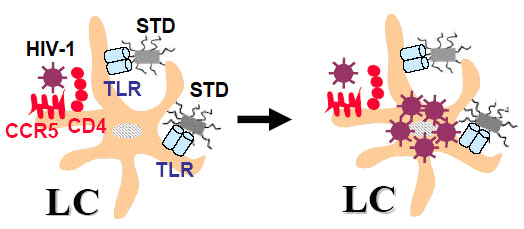Kawamura M.D., Ph.D. Research Group
The role of Toll-like receptor
in HIV infection caused by sexual activity
- The risk of HIV infection known as a sexually transmitted disease (STD) is increasing. STDs are caused by bacteria, viruses, and fungus. The penetration of these pathogens into biological object is perceived by the Toll-like receptor (TLR) existing on the dendritic cell.
- Recent studies shows that the HIV infected targeting cell is found in the skin and mucosa of the Langerhans cells (LC) as a dendritic cell subtype.
Based on the above information, we have studied our hypothesis. The hypotheses is that the HIV infection of a host is promoted by that STD causative agent stimulates TLR which occurs in the skin and the mucosa LC and it increases the production of the HIV LC virus.

Based on our research, we have proved that following items from a.to e. by applying the human monocyte-derived LC-like dendritic cells which have human skin LC characteristics and are widespread, and using the isolated epidermal LC from the skins which volunteers patients have given consent to let us test for our hypothesis.
- Using the FACS we discovered that the LC leads to expression of TLR1, TLR2, TLR3, and TLR6, and that the gram-positive coccus or other kinds of viruses within the causative agent can be seen in the skin and mucosa.
- Expressing TLR1-3, and 6 on the LC is functional. We applied the TLR ligands kit (TLR1~9 ligands、Invivogen®) for the LC, and tested it and studied for the expressed inducibility of CD83/CD86 as a cell-activation marker and the production of cytokine over a 24 hours period.
- Before and after passing to HIVBa-l(R5HIV), with the TLR ligands kit, the involvement of the STD HIV susceptibility to infection (entry) and the amount of HIV replicated (replication) and their mechanisms; LC-like DC; and epidermal LC were studied. Prior treatment reflected as entry and post treatment as replication. After cultivating them for a week, the FACS determined the quantity of the HIV infection LC while utilizing the monoclonal antibody for HIV p24. As a result, we found that the LC HIV entry and replication were significantly increased by giving treatments for Listeria monocytogenes (Gram-positive anaerobic) as TLR2 ligand, lipoprotein as Gram-positive anaerobic as a fungal constituent, LTA, and PGN, as opposed to no treatments.
- In this mechanism, the TLR2 ligand up-regulates CD4 of LC-like DC (FACS).
- TLR2 ligand lowers the expressions of APOBEC3G/3F as the retrovirus duplicated inhibitory agent (real-time PCR).